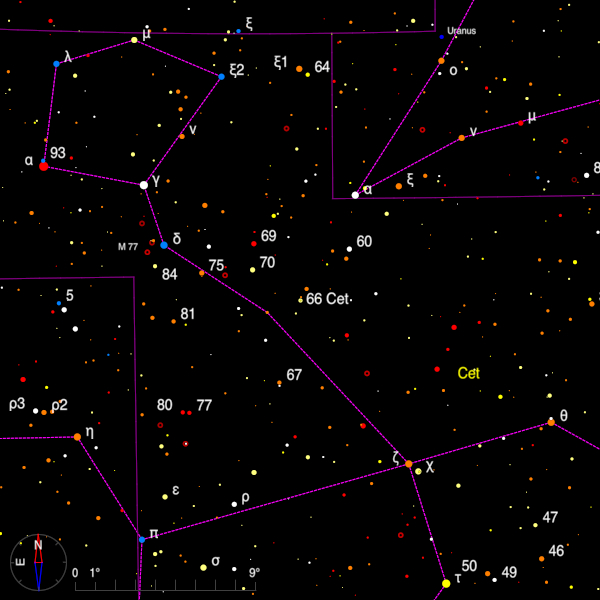November 2021 - Double Star of the Month
On the border of Andromeda and Cassiopeia, about 15 degrees north-west of gamma And, is the naked-eye star phi And (01 09 30.12 +47 14 30.6). This has long been known as a close and difficult visual binary, having been discovered by Otto Struve at Pulkova in the 1840s.

The orbital period is long, a recent estimate put it at 554 years, but at present it is slightly wider than 0".5 and is thus within range of 25-cm, although 20-cm might well show an elongation. The stars are not equally bright, the Washington Double Star Catalog (WDS) gives values of 4.6 and 5.6 for the magnitudes.
Within 2 degrees of phi there are three other double stars marked in the Cambridge Double Star Atlas, 2nd edition. Two of these (MAD 1 and STT 21) will be discussed in this column next year.
The other is BU 397 which lies 40' south-west of phi. The stars are magnitudes 7.5 and 10.3 at PA 142 degrees and separation 8".7. This pair was actually discovered by John Herschel, but S. W. Burnham noted that Herschel had made an error of 1 degree in declination. Burnham also added a fainter and more distant star - 12.9 at 72 degrees and 19".3.
66 Cet (02 12 47.54 -02 23 37.1) is a beautiful wide pair to be found 1.5 degrees WNW of Mira Ceti, the famous long period variable star. Mira reached maximum brightness in August 2021, so judging by previous light curves it is expected to be about V = 7.5 by mid-November.

66 Ceti has stars of spectral types F8V and G1V and visual magnitudes 5.7 and 7.7. The position angle of 235 degrees and separation of 16".8 has remained unchanged since 1783 when the pair was noted by William Herschel. This is almost certainly a physical pair, since in addition to very similar parallaxes the two stars have the same considerable proper motion.
In addition, the A component, which was known to be a spectroscopic binary, has recently been resolved by Dr. Andrei Tokovinin at Cerro Tololo using the 4 metre SOAR telescope, The period is 94 days and the angular separation is under 0".02.
A more distant star of V = 11.5 is optical. I found the primary stars to be yellowish and lilac with a 21-cm reflector.
Bob Argyle - Double Star Section Director